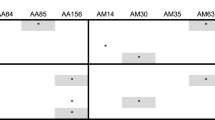Summary
A set of 167 ‘mucromphs’ was evaluated in their F1 generation for seven ‘plant’, four ‘plot’ and five ‘ratio’ characters. Methods of characterizing the parents and the hybrids on the basis of combining ability effects described in the first part were found to be efficient in identifying desirable cross combinations for pedigree breeding or generating composite populations. Order effects of multiple-pollen combinations were found to be potent for a number of character components. High x Low cross-combinations were found to produce a high frequency of heterotic crosses followed by High x High. Selected biparental progenies, single crosses, three-way crosses and elite varieties were successful female parents and combinations of pollen from two varieties, one variety and three varieties were successful male parents, in that order, in producing significant heterosis in mucromphs. The relationship between general and specific combining ability on the one hand and realised heterosis on the other was discussed.
Similar content being viewed by others
Literature
Arunachalam, V. (1977): Heterosis for characters governed by two genes. J. Genet. 63, 15–24
Arunachalam, V.; Bandyopadhyay, A. (1979): Are ‘Multiple crossmultiple pollen hybrids’ an answer for productive populations in Brassica campestris var. ‘brown sarson’? 1: Methods for studying ‘Mucromphs’. Theor. Appl. Genet. 54, 203–207
Arunachalam, V.; Katiyar, R.K. (1978): Genetic diversity and breeding potential from disruptive selection in Brassica campestris cv ‘brown sarson’. Expl. Agric. 14, 1–7
Arunachalam, V.; Reddy, B.B. (1980, in press): Evaluation of heterosis through combining ability in pearl millet. 2. Multiple crosses. Indian J. Genet.
Arunachalam, V.; Srivastava, P.S.L. (1980): Assessment of genetic potential of multiple crosses in triticale. Genet. Agr. 35, 117–127
Das, G.R. (1979): Short-term strategies of population breeding from multiple crosses in rapeseed (Brassica campestris L.). Ph.D. thesis, P.G. School, IARI., New Delhi
Fejer, S.O.; Jui, P.Y. (1979): Genotype-environment interactions in single seed propagated barley diallel. Cereal Res. Comm. 7, 85–91
Gill, K.S.; Dhillon, S.S.; Arora, B.S. (1974): Line x Tester analysis of combining ability and heterosis in wheat. Breeding researches in Asia and Oceania. Indian J. Genet. 34A, 601–609
Jensen, N.F. (1970): A diallel selective mating system for cereal breeding. Crop Sci. 10, 629–635
Langham, D.G. (1961): The High-low method in crop improvement. Crop Sci. 1, 376–378
MacKey, J. (1965): Combination procedures in wheat and barley breeding. FAO Bulletin 16, 13–17
Mangelsdorf, P.C. (1939): Use of multiple top-crosses in southern corn improvement. Mimeo. Rept. First Southern Corn Improvement Conf. 1, 33–35
Rao, N.G.P. (1972): Sorghum breeding in India: recent developments. in: Sorghum in seventies. (eds.: Rao, N.G.P.; House, L.R.), pp. 101–142. New Delhi, Bombay, Calcutta: Oxford and IBH.
Rao, N.G.P.; Rana, B.S. (1978): Characterization of tropical and temperate sorghums and their utilization. Proc. Nat. Symp. Plant and Animal Genetic Resources, New Delhi. 28–30
Redden, R.J.; Jensen, N.F. (1974): Mass selection and mating system in cereals. Crop Sci. 14, 345–350
Reddy, B.B.; Arunchalam, V. (1980, in press): Evaluation of heterosis through combining ability in pearl millet. I. Single crosses. Indian J. Genet.
Singh, K.B.; Jain, R.P. (1971): Analysis of diallel cross in Phaseolus aureus Roxb. Theor. Appl. Genet. 41, 279–281
Singh, T.P.; Singh, K.B. (1974): Heterosis and combining ability in Phaseolus aureus Roxb. Theor. Appl. Genet. 44, 12–16
Singhania, D.L. (1972): Heterosis, line per se performance, combining ability and stability of performance in grain sorghum (Sorghum vulgare bicolor (L) Moench.). Ph.D. Thesis, P.G. School, IARI., New Delhi
Theurer, J.C.; Ellig, L.J. (1964): Comparative performance of diallel crosses and related second generation synthetics of alfalfa, Medicago sativa L. 3: Forage yield. Crop Sci. 4, 25–28
Author information
Authors and Affiliations
Additional information
Communicated by B.R. Murty
Rights and permissions
About this article
Cite this article
Bandyopadhyay, A., Arunachalam, V. Are ‘multiple cross-multiple pollen hybrids’ an answer for productive populations in Brassica campestris (var.) Brown Sarson?. Theoret. Appl. Genetics 58, 5–10 (1980). https://doi.org/10.1007/BF00264659
Received:
Issue Date:
DOI: https://doi.org/10.1007/BF00264659




